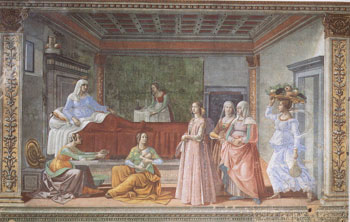
|
|
| |
 |
|
|
|
Figure 2: Birth of St. John
the Baptist, Ghirlandaio, 1486. This is a good illustration showing
gamurre worn by several different classes of women. |
|
| |
 amurre
were worn by all types of women. An excellent illustration of this
is Figure 2, The Birth of St. John the Baptist by Domenico
Ghirlandaio. In this painting, several classes can be seen. First
in the center background, is a serving maid wearing a red gamurra
with green sleeves. Second, in the left foreground, are two wet nurses.
One is wearing an orange gamurra with green sleeves, the other a blue
gamurra under a simple green overdress or ropa. Finally, in the center
front of the painting are the Patrons. The younger woman in front
is wearing a patterned or embroidered beige gamurra under a pink giornea,
while her older companion to the left wears what looks like a green
gamurra with gold sleeves under a gold damask overdress, perhaps a
cioppa. Another painting demonstrating this is The Resurrection
of the Boy, by Ghirlandaio (Figure 3).
The gamurra is seen on four different women, at least 3 of which are
sisters. Note the pink gamurra with green sleeves, the red gamurra
under the blue cioppa, the red under the beige giornea as well as
the more simply cut black gamurra. The simplicity and plainness of
this example suggests the wearer to be an attendant or servant of
some type. amurre
were worn by all types of women. An excellent illustration of this
is Figure 2, The Birth of St. John the Baptist by Domenico
Ghirlandaio. In this painting, several classes can be seen. First
in the center background, is a serving maid wearing a red gamurra
with green sleeves. Second, in the left foreground, are two wet nurses.
One is wearing an orange gamurra with green sleeves, the other a blue
gamurra under a simple green overdress or ropa. Finally, in the center
front of the painting are the Patrons. The younger woman in front
is wearing a patterned or embroidered beige gamurra under a pink giornea,
while her older companion to the left wears what looks like a green
gamurra with gold sleeves under a gold damask overdress, perhaps a
cioppa. Another painting demonstrating this is The Resurrection
of the Boy, by Ghirlandaio (Figure 3).
The gamurra is seen on four different women, at least 3 of which are
sisters. Note the pink gamurra with green sleeves, the red gamurra
under the blue cioppa, the red under the beige giornea as well as
the more simply cut black gamurra. The simplicity and plainness of
this example suggests the wearer to be an attendant or servant of
some type. |
| |
|
|
| |
|











